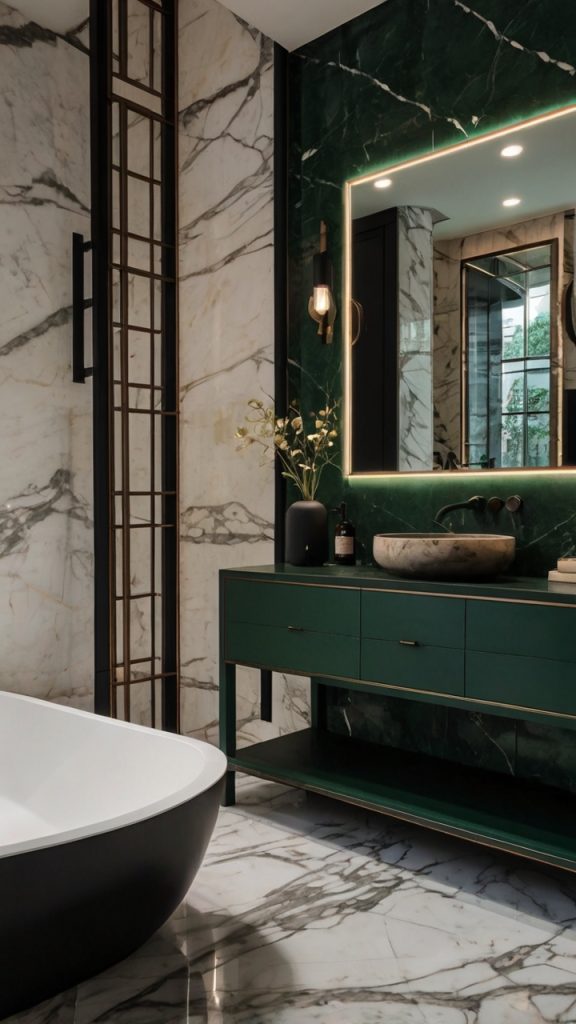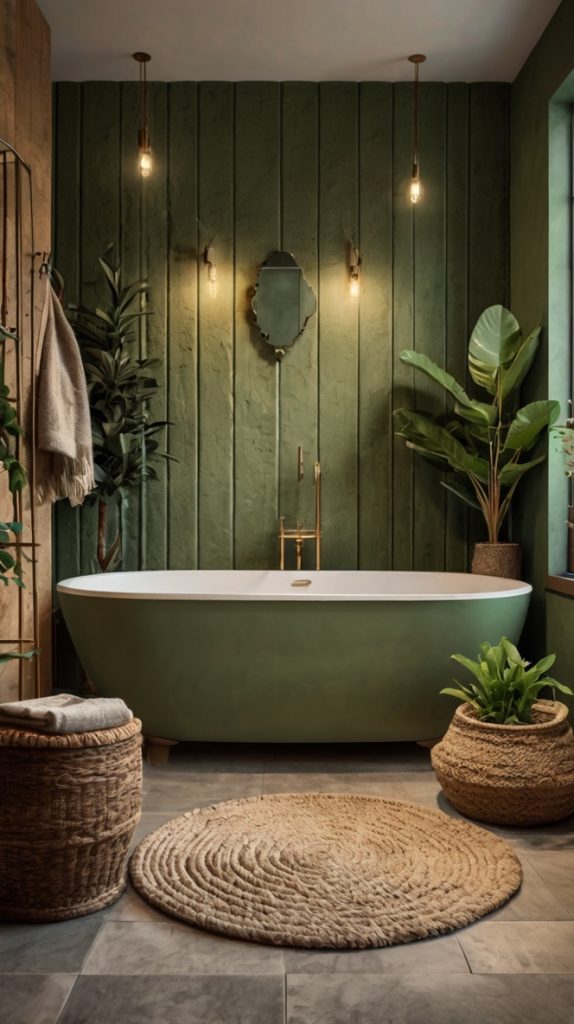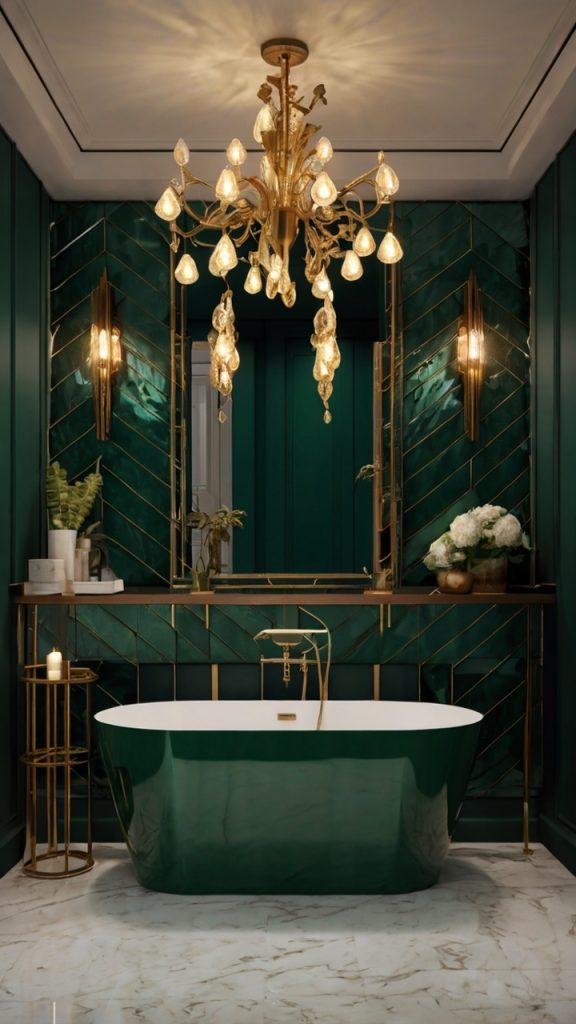15 Gorgeous Small Space Living Room Ideas for Modern Homes
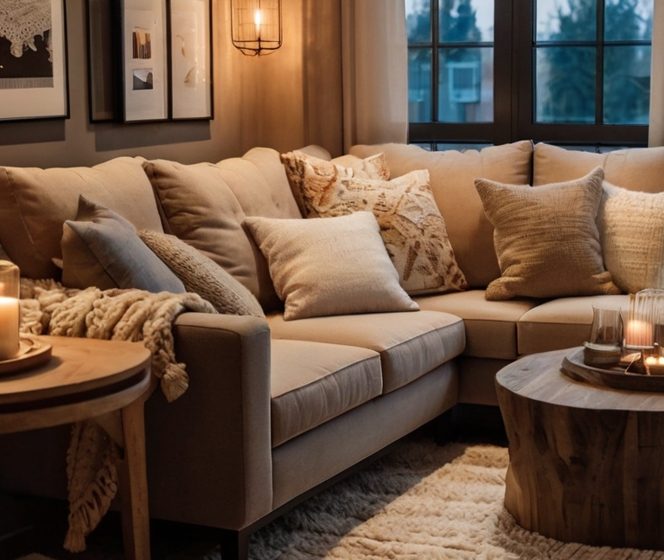
You know that feeling when you walk into your tiny living room and wonder if you accidentally rented a glorified closet? Yeah, been there. My first apartment’s living room was so small, I could practically touch both walls if I stretched out my arms – and I’m not exactly NBA material here.
But here’s the thing: small living rooms can be absolutely stunning when you know what you’re doing. After spending years perfecting my own shoebox-sized spaces (and helping friends transform theirs), I’ve discovered that size really doesn’t matter. What matters is how clever you get with what you’ve got.
So grab your coffee, get comfy, and let me share 15 game-changing ideas that’ll transform your cramped quarters into a space that feels twice its actual size. Trust me, your small living room is about to become your favorite room in the house.
Minimalist Small Living Room Layout
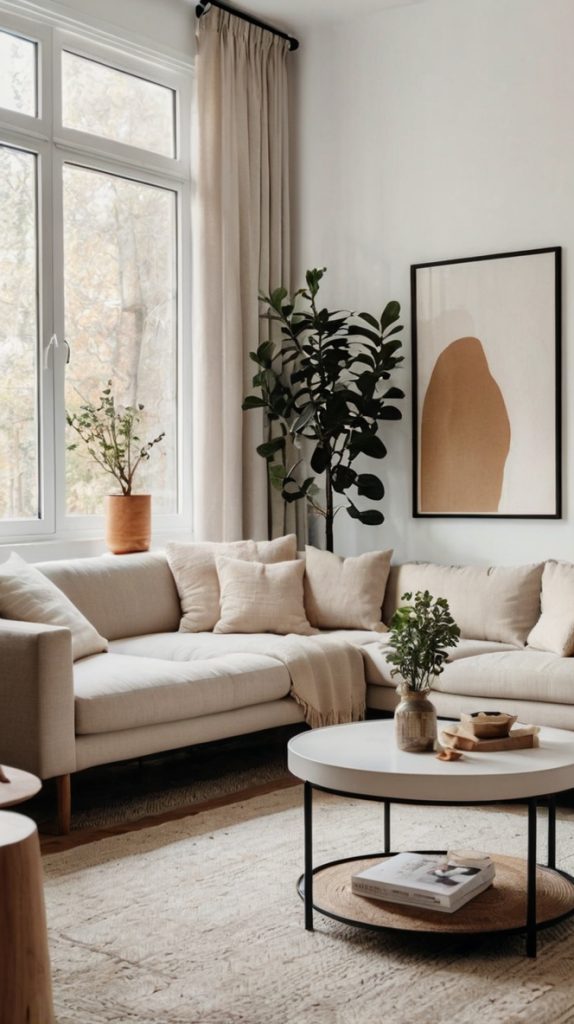
Let’s start with the golden rule of small spaces: less is always more. I learned this the hard way when I tried cramming every piece of furniture I owned into my 200-square-foot living room. Spoiler alert: it looked like a furniture store exploded.
The minimalist approach isn’t about living like a monk – it’s about being intentional with every single item. Choose one stunning sofa instead of a couch and two chairs. Pick a sleek coffee table that doesn’t dominate the room. Every piece should earn its spot by serving a purpose AND looking fantastic.
Here’s what I do now: I map out my room on paper first (old school, I know), then place only the essentials. The magic number is usually 3-5 main pieces, depending on your room size. This creates breathing room and makes your space feel instantly larger.
The Power of Negative Space
Ever notice how high-end hotels make small rooms feel luxurious? They master negative space – those empty areas that give your eyes a rest. Don’t fill every corner just because you can. That empty spot beside your sofa? Leave it. Your room will thank you for it.
Multi-Functional Furniture Setup
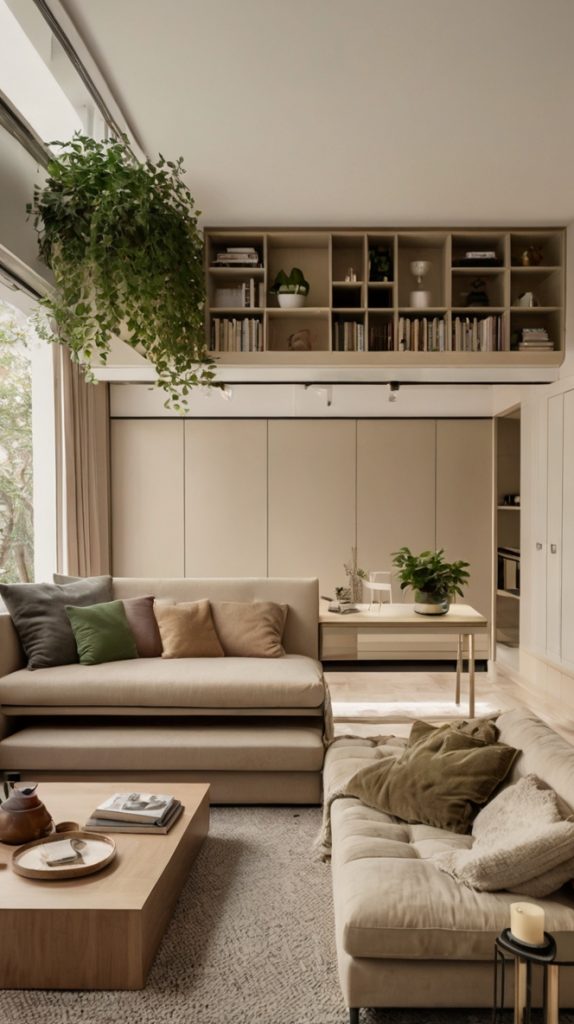
Okay, this is where things get exciting. Multi-functional furniture is basically the Swiss Army knife of interior design. My ottoman? It’s also storage, extra seating, and sometimes my coffee table. That console table behind my sofa? It’s my workspace during the day.
I recently discovered this incredible sofa bed that doesn’t look like those awful futons from college. It actually looks like a proper, stylish couch – guests never know it transforms until I tell them. The key is finding pieces that don’t scream “I’M HIDING SOMETHING!” at first glance.
Smart Shopping Tips for Multi-Use Pieces
- Storage ottomans that can hold blankets, games, or your secret snack stash
- Nesting tables that tuck away when not needed
- Expandable dining tables that go from intimate to party-ready
- Benches with hidden storage for the entryway area
Light and Airy Color Palette Design
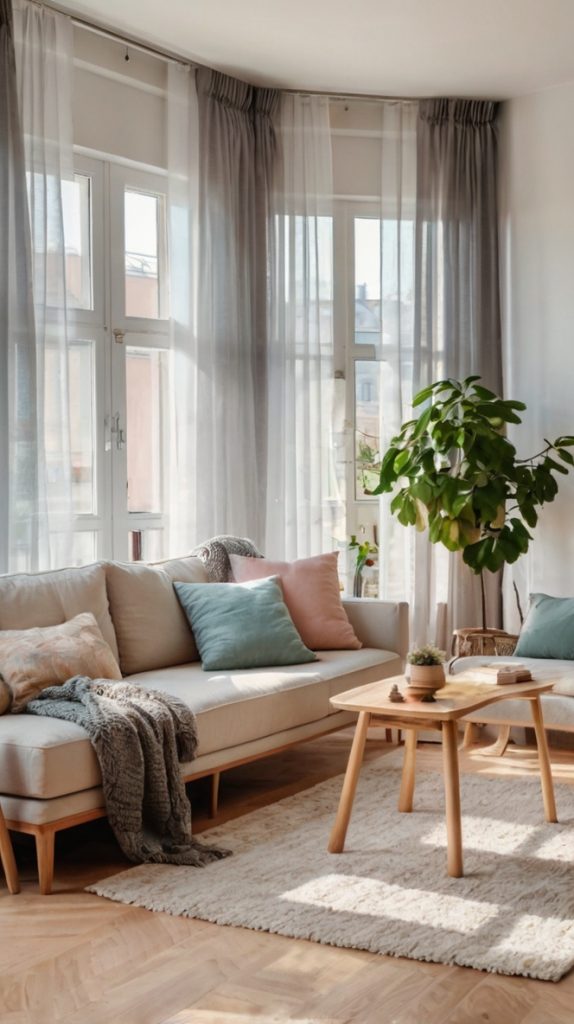
Want to know the fastest way to make your room feel bigger? Paint it white. Okay, maybe not stark hospital white, but you get the idea. Light colors reflect light, making spaces feel open and airy. Dark colors, while moody and gorgeous, tend to close things in.
My living room walls are painted in this perfect shade called “Cloud White” – creative name, right? But seriously, it transformed the space. The walls seem to recede, and suddenly my tiny room feels like it could host a small party.
Don’t think you’re stuck with boring though. I add personality through colorful throw pillows, artwork, and plants. The base stays light, but the accessories bring the fun. Think of it as wearing a white t-shirt with statement jewelry – classic base, personality on top.
Also Read: 15 Elegant Hallway Wall Decor Ideas and Timeless Charm
Cozy Corner Sofa Arrangement
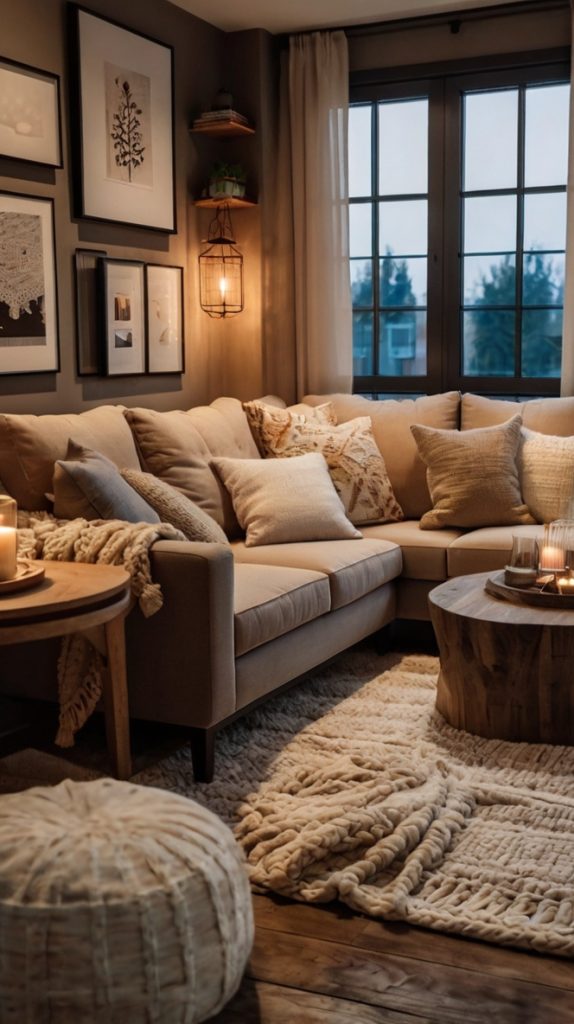
Who says small spaces can’t have sectionals? A well-placed corner sofa can actually maximize your seating while taking up less floor space than separate pieces. The trick is choosing the right size and placing it strategically.
I position mine in the corner (shocking, I know), which opens up the center of the room for movement. This creates a natural flow and makes the room feel less like an obstacle course. Plus, corner sofas create this cozy nook feeling that makes everyone want to curl up with a book.
Measuring for Success
Before you fall in love with that L-shaped beauty online, measure twice, buy once. Leave at least 24-30 inches of walkway around your sofa. Any less and you’ll be doing that awkward shuffle dance every time you walk through.
Wall-Mounted Storage Solutions
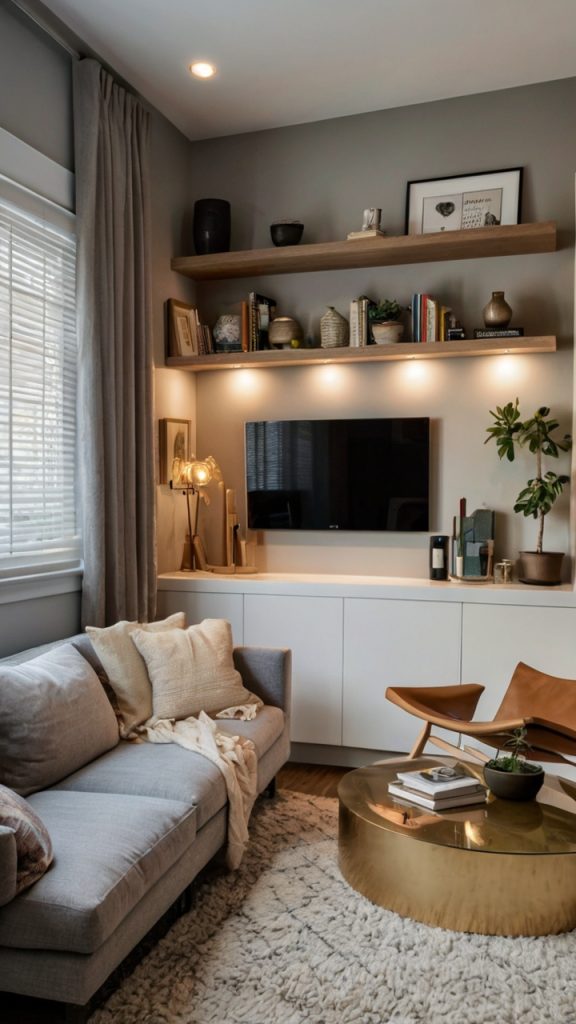
Floors are precious real estate in small spaces, so why clutter them with storage units? Take your storage vertical with wall-mounted solutions. I mounted everything I could – TV, shelves, even my record player setup.
The transformation was instant. Suddenly, I had all this floor space that made my room feel twice as big. Wall-mounted desks are particularly genius for small living rooms that double as home offices. They fold up when not in use, disappearing like they were never there.
My favorite trick? Mounting storage at different heights creates visual interest while maximizing every inch of wall space. Just make sure you hit those studs – nobody wants their TV crashing down mid-Netflix binge.
Mirrors for Spacious Illusion
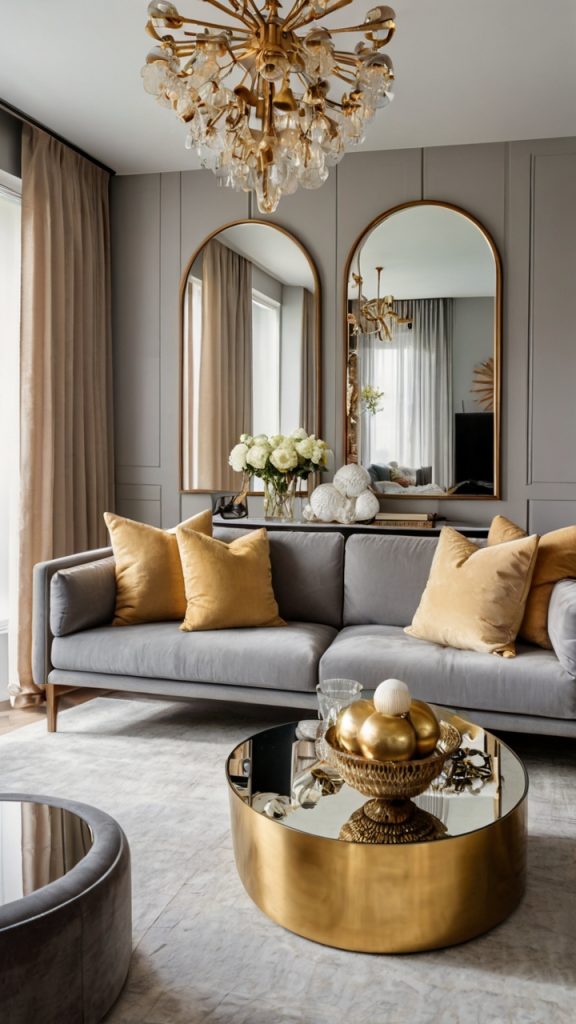
Ever walked into a restaurant bathroom and thought it was huge, only to realize it’s all mirrors? That’s the power of reflection, my friend. A strategically placed mirror can literally double your visual space.
I have this oversized mirror leaning against my wall (too lazy to mount it, honestly), and it reflects my window, doubling the natural light. Guests always comment on how spacious my living room feels. Little do they know it’s all smoke and mirrors – literally.
Mirror Placement Strategy
Position mirrors across from windows to maximize natural light. Avoid placing them where they’ll reflect clutter or less attractive views (nobody needs to see your messy kitchen from the living room). Large mirrors work better than multiple small ones – they create a cleaner, more expansive look.
Also Read: 15 Amazing Large Wall Decor Living Room Ideas You’ll Love
Floating Shelves Decor
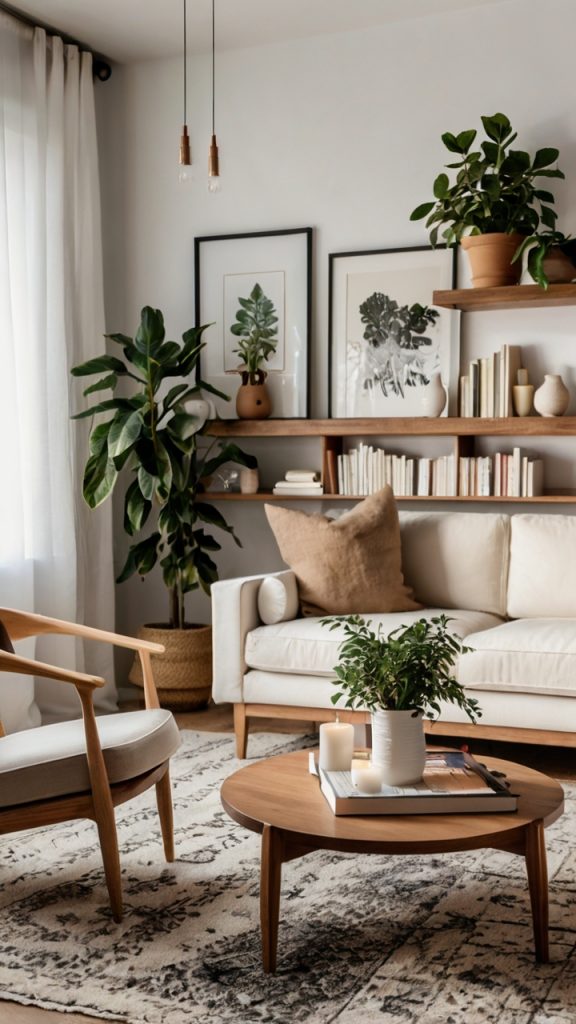
Floating shelves are like the unsung heroes of small space living. They provide storage and display space without the visual weight of traditional bookcases. I installed three simple white shelves, and suddenly I had a place for books, plants, and those random decorative objects I can’t seem to stop buying.
The beauty of floating shelves? They don’t interrupt the eye line, keeping your walls feeling open. I arrange mine asymmetrically because perfect symmetry can feel a bit rigid. Mix books with plants, add a small piece of art – make it personal but not cluttered.
Keep the styling minimal though. The “shelfie” trend might look great on Instagram, but in real life, overstuffed shelves make small rooms feel chaotic. Aim for 30% decorative items, 70% negative space on each shelf.
Neutral Tone Scandinavian Style
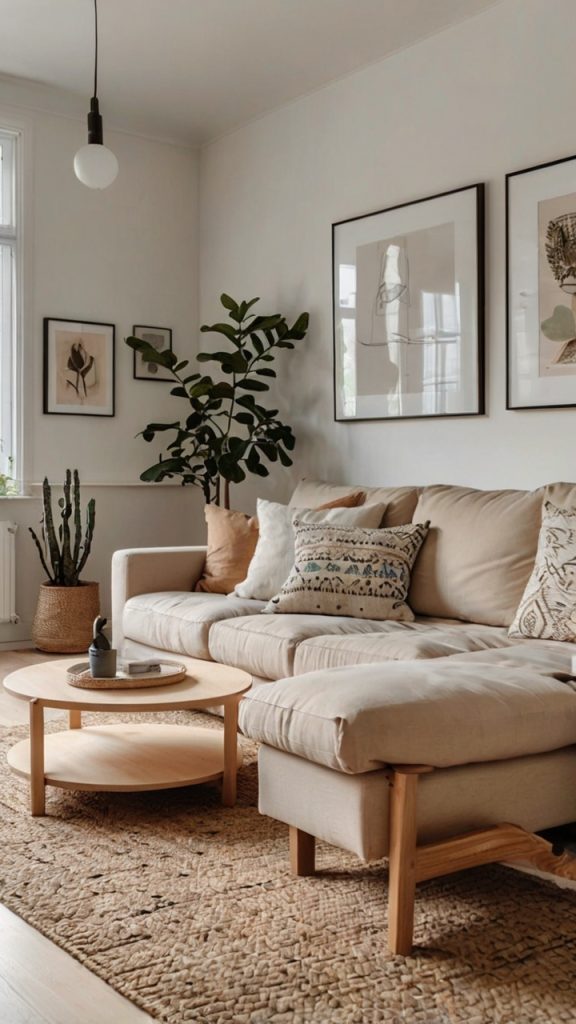
The Scandinavians really know what they’re doing when it comes to small spaces. Their style is all about functionality meeting beauty, with a heavy dose of hygge (that cozy feeling you can’t quite describe).
I adopted this style after visiting Copenhagen and falling in love with their approach. Neutral tones – whites, grays, beiges – create a calming base. Add warmth through natural wood furniture and soft textiles. The result? A space that feels both minimal and inviting.
Essential Scandinavian Elements
- Natural materials like wood, wool, and linen
- Clean lines without being cold
- Cozy textiles that invite touching
- Functional beauty – everything serves a purpose
The best part? This style is incredibly forgiving for small spaces. The neutral palette makes everything feel cohesive, even when you’re mixing furniture from different sources (hello, budget-friendly shopping!).
Compact Boho Chic Living Room
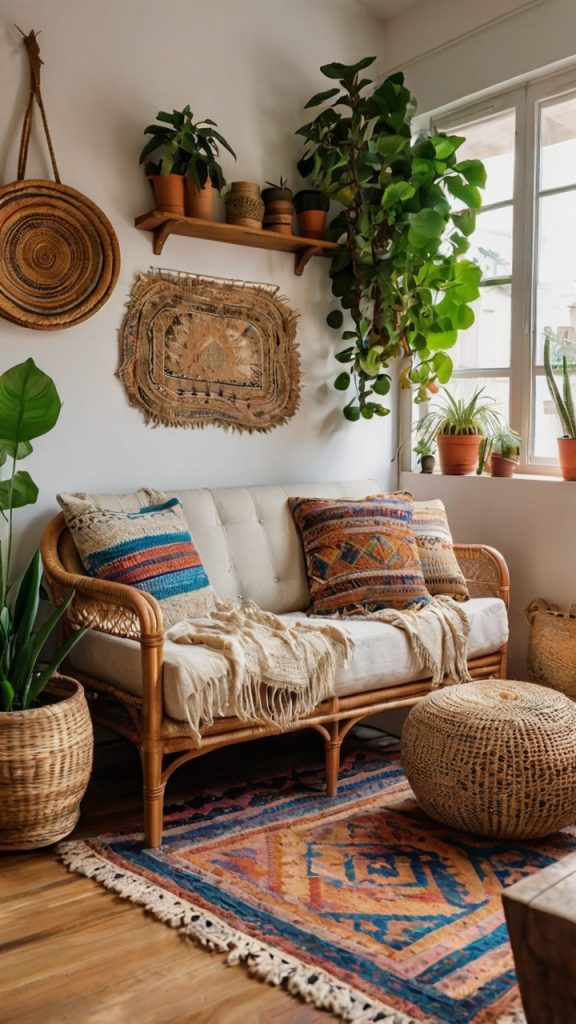
Who says boho style is only for sprawling lofts? You can absolutely rock the bohemian vibe in a tiny space – you just need to be strategic about it. The key is controlling the chaos that can come with boho’s “more is more” philosophy.
I achieve this look by keeping larger pieces neutral and adding boho elements through textiles and accessories. A simple gray sofa becomes boho with the right throw pillows and a textured blanket. One statement piece – like a vintage Moroccan rug or a macramé wall hanging – sets the tone without overwhelming.
Layer textures instead of colors if your space is really tight. Different fabrics, weaves, and materials create that collected-over-time boho feel without the visual noise of too many patterns.
Also Read: 15 Stunning Black Sofa Living Room Decor Ideas to Inspire
Foldable and Hidden Furniture Ideas
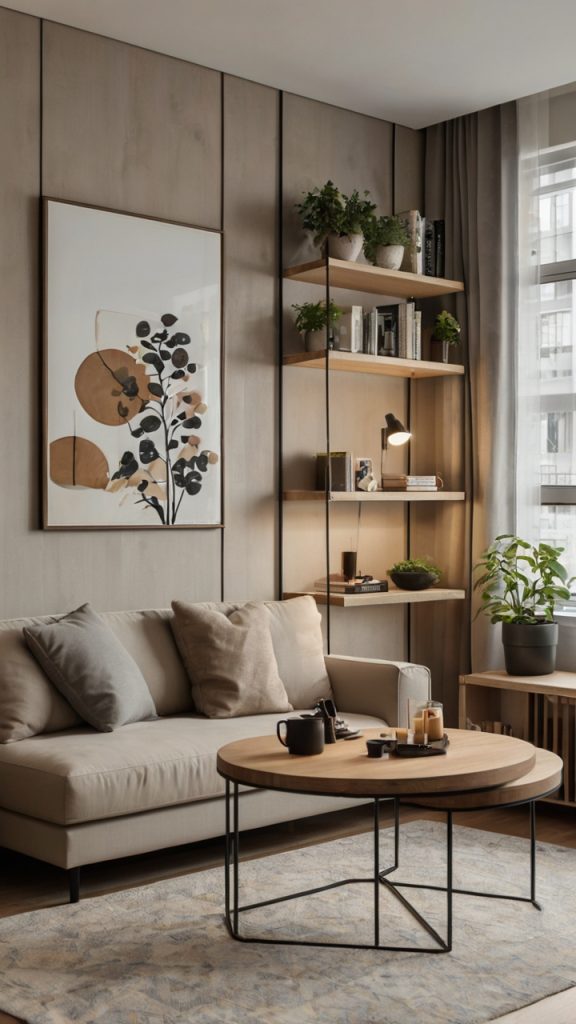
Real talk: foldable furniture has come a long way from those metal folding chairs at family reunions. Today’s options are stylish enough that nobody will know they collapse.
My coffee table? It folds flat against the wall when I need floor space for yoga (which happens maybe twice a year, but still). I have gorgeous wooden TV trays that look like art pieces when folded. Even found bar stools that disappear completely under my counter when not in use.
Hidden Furniture Game Changers
Here’s what actually works:
- Drop-leaf tables that expand for dinner parties
- Murphy desks that fold into a slim cabinet
- Stackable stools that create a sculptural element when stored
- Collapsible room dividers for instant privacy
The trick is buying quality pieces that don’t feel flimsy. Yes, they cost more upfront, but they’ll actually get used instead of being shoved in a closet.
Vertical Space Optimization

Look up. See all that empty space near your ceiling? That’s wasted real estate! Vertical optimization is about using every inch from floor to ceiling, not just eye level.
I installed shelving units that go all the way up, using the top shelves for items I don’t need daily. Tall, narrow furniture pieces draw the eye upward, making ceilings feel higher. Even hanging plants from the ceiling adds life without taking up precious surface space.
One game-changer: ceiling-mounted curtain tracks positioned several inches above the window frame. This trick makes windows appear larger and ceilings higher. It’s basically an optical illusion that costs nothing extra.
Open Concept Small Living Room
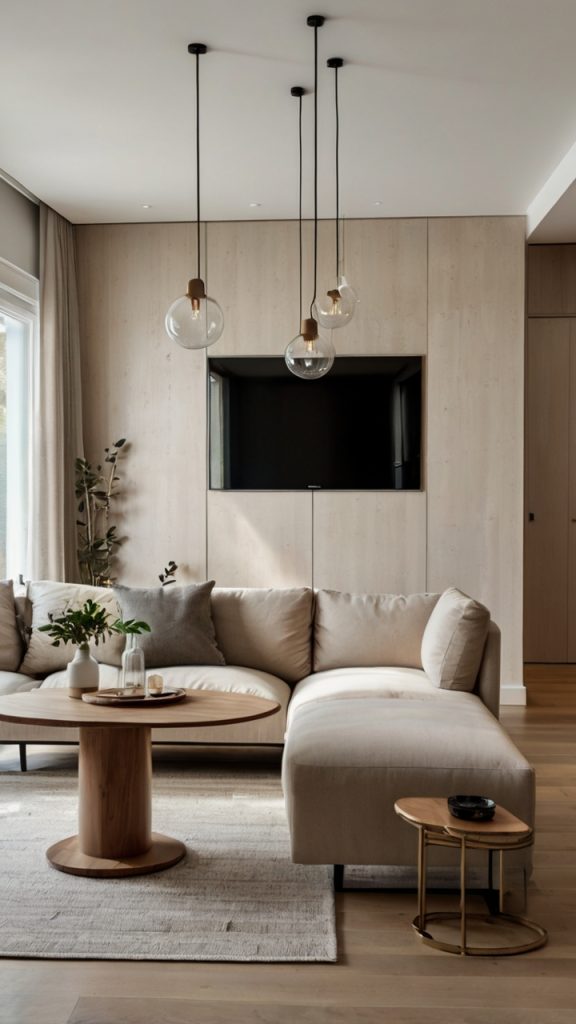
Breaking down visual barriers can make your small living room feel part of a larger whole. Open concept doesn’t mean knocking down walls (though if you can, go for it!). It means creating visual flow between spaces.
I removed the doors between my living room and kitchen, instantly doubling the perceived space. Using the same flooring throughout creates continuity. Keeping the color palette consistent between rooms makes everything feel cohesive.
Creating Zones Without Walls
Define different areas using:
- Rugs to anchor seating areas
- Lighting to create intimate spaces
- Furniture placement as natural dividers
- Different ceiling treatments for subtle separation
The goal is making each area functional while maintaining that open, airy feeling. FYI, this approach works amazingly well for studio apartments too 🙂
Natural Light Enhancement Tips
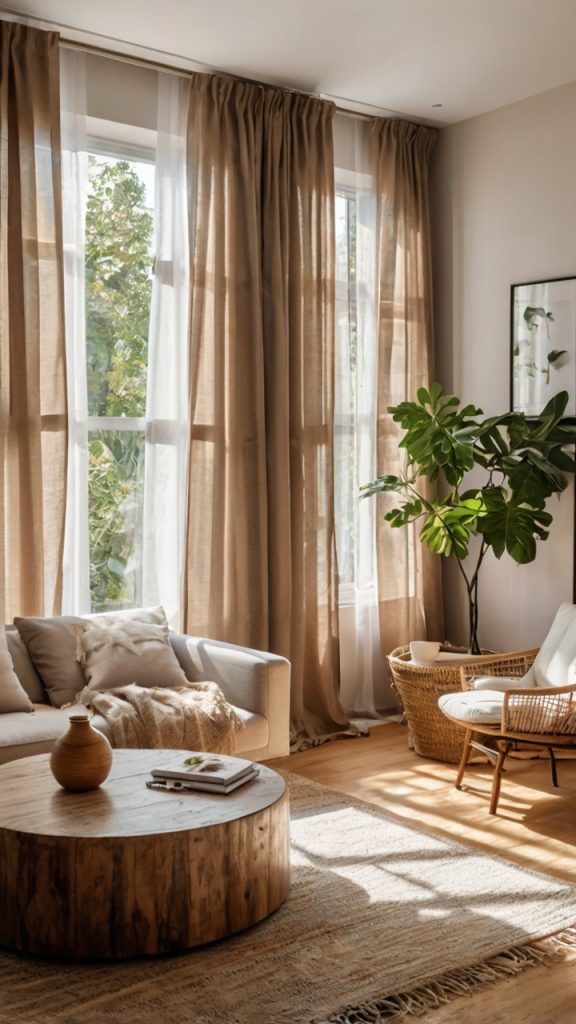
Natural light is basically a small room’s best friend. The more light you let in, the bigger your space feels. But what if your windows are tiny or facing a brick wall?
First, ditch those heavy curtains. I switched to sheer white panels that provide privacy while letting light flood in. Clean your windows regularly (I know, boring adulting stuff) because dirty windows can block up to 30% of light.
Light-Boosting Tricks That Actually Work
Here’s what I do to maximize every photon:
- Remove window screens during months you don’t need them
- Use metallic accents to bounce light around
- Choose glossy paint finishes for trim and ceilings
- Position mirrors strategically to reflect window light
- Keep window sills clear – those cute plants might be blocking light
Also, paint your ceiling white if it isn’t already. A dark ceiling makes rooms feel cave-like, while white makes them feel infinite.
Smart TV Wall and Media Setup
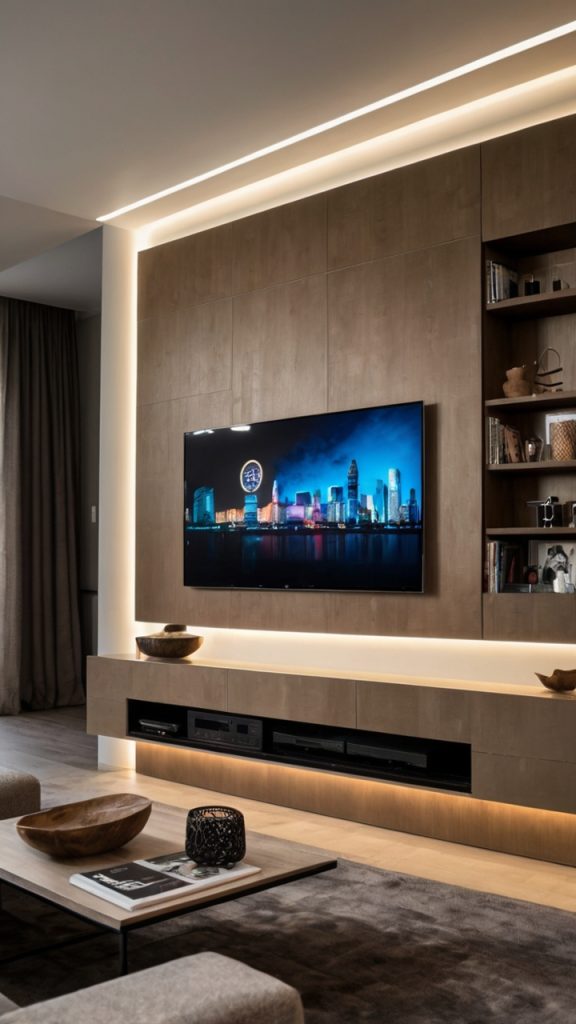
Remember when TVs were these massive boxes that dominated the room? Thank goodness those days are over. Today’s flat screens can practically disappear when mounted properly.
I mounted my TV on a swivel bracket, so I can angle it toward the kitchen when cooking or hide it flat against the wall when entertaining. The cables run through the wall (hired a pro for this – electricity and DIY don’t mix, IMO).
Skip the bulky media console. Instead, I use a slim floating shelf underneath for the cable box and game console. Everything else streams anyway, right? This setup freed up so much floor space, I actually did a little happy dance when I finished.
Tech Organization Tips
- Use cord covers painted to match your walls
- Choose wireless speakers when possible
- Hide equipment in decorative boxes with ventilation
- Consider a projector instead of a TV for ultimate space-saving
Statement Rug for Small Spaces

Here’s something counterintuitive: a large rug actually makes a small room feel bigger than a tiny one. I learned this after years of buying rugs that were too small, making my furniture look like it was floating on little islands.
The right rug pulls everything together, defines the seating area, and adds personality without taking up any vertical space. I splurged on a gorgeous Persian-style rug that basically makes my entire living room. Everything else is simple, but that rug? That’s where the magic happens.
Rug Sizing Rules
Follow these guidelines for the perfect fit:
- All furniture legs on the rug (ideal but not always possible)
- At least front legs of major pieces on the rug
- 8-10 inches of bare floor around the room’s perimeter
- Rectangular rooms look best with rectangular rugs
Pro tip: Layer a smaller vintage rug over a larger neutral one for that collected-over-time look without the collected-over-time price tag.
Bringing It All Together
So there you have it – 15 ideas that’ll transform your small living room from cramped to incredible. The secret isn’t about having more space; it’s about using the space you have intelligently.
I’ve lived in small spaces my entire adult life, and honestly? I wouldn’t trade them for a mansion. There’s something incredibly satisfying about creating a beautiful, functional room within constraints. It forces creativity, encourages minimalism, and results in spaces that feel intentional rather than default.
Start with one or two ideas that resonate with you. Maybe it’s finally mounting that TV or investing in a statement mirror. Small changes lead to big transformations. Your tiny living room has massive potential – you just need to unlock it.
Remember, the best small living room is one that works for YOUR life. Whether you’re team minimalist or boho maximalist, there’s a way to make it work in your space. The only rule that really matters? Love where you live, no matter how many (or few) square feet you’re working with.
Now stop reading and start transforming. Your dream living room is waiting, and trust me, it’s going to be amazing – small size and all :/
